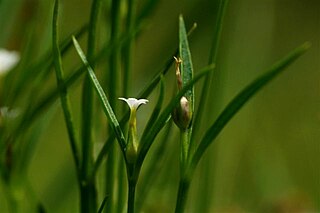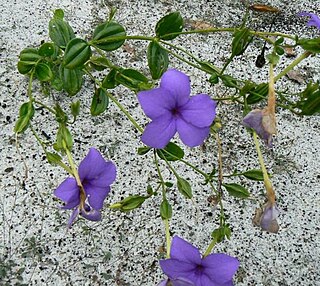
Gentianaceae is a family of flowering plants of 105 genera and about 1600 species.

Anthocleista is a genus of tree- and shrub-like tropical plants in the subtribe Potaliinae in the Gentian family. There are between 14 and 16 species in the genus, native mainly to tropical Africa, including Madagascar and the Mascarene Islands. Anthocleista was once placed in the family Loganiaceae, but more recent molecular, morphological, and phytochemical evidence has placed the group well within the Gentianaceae.

Exacum is a genus of plant in family Gentianaceae. It contains 75 species native to tropical regions of sub-Saharan Africa, southern Arabian Peninsula, south and southeast Asia, New Guinea, and Australia.

Pyrostria is a genus of dioecious flowering plants in the family Rubiaceae. Most of the species are endemic to Madagascar, others occur on islands in the western Indian Ocean, a few are found in continental Africa, and only six species occur in tropical Southeast Asia. The formerly recognized genus Leroya, containing two species endemic to Madagascar, L. madagascariensis and L. richardiae, was sunk into synonymy with Pyrostria.

Sebaea is a genus of annual plants in the family Gentianaceae. Species occur in Africa, Madagascar, India, China, Thailand, Australia and New Zealand. The genus was paraphyletic and has been split in four genera: Exochaenium, Klackenbergia, Lagenias and Sebaeas.str.. Synapomorphies for Sebaea s.str. include the presence of extra stigma along the style and the shape of the testa cells of the seeds.
Secamonopsis microphylla is a plant species endemic to southern Madagascar. It is a trailing or erect herb up to 1.5 m tall. Leaves are narrowly oblong, up to 10 mm long. Flowers in groups of 1–3, yellow, tubular, up to 1.2 mm long.
Secamone schatzii is a plant species endemic to Madagascar. It grows in lowland rainforest in the eastern part of the country. The species is named in honor of George Schatz of the Missouri Botanical Garden.

Genianthus is a genus of plants in the family Apocynaceae, first described as a genus in 1883. It is native to southern China, the Indian Subcontinent, and Southeast Asia.
Pentopetia is a plant genus in the family Apocynaceae, first described as a genus in 1844.
Pervillaea is a genus of plants in the family Apocynaceae, first described as a genus in 1844. It is native to Mauritius and Madagascar in the Indian Ocean.
- Pervillaea brevirostrisKlack. - Mauritius
- Pervillaea decaryi(Choux) Klack. - Madagascar
- Pervillaea phillipsoniiKlack. - Madagascar
- Pervillaea tomentosaDecne. - Madagascar
- Pervillaea venenata(Baill.) Klack. - Madagascar
Calyptranthera is a genus of plants in the family Apocynaceae, first described as a genus in 1996. The entire genus is endemic to Madagascar in the Indian Ocean.

The genus Exochaenium is endemic to sub-Saharan Africa, with species occurring in most tropical and sub-tropical regions of the continent, particularly on the Katanga plateau, with many extending to the Sudano-Zambesian and Guineo-Congolian regions. The genus is monophyletic and is used to study the variation and evolution of herkogamy.

Klackenbergia is a genus of flowering plants belonging to the gentian family (Gentianaceae) and the tribe Exaceae. It only contains two species, both endemic to Madagascar. They are notable for their inflorescence with characteristic long bracts and bracteoles and sub-sessile flowers arranged in axillary fascicules at each node.

Exaceae is a flowering plant tribe in the family Gentianaceae. Exaceae comprises about 180 species assigned to eight monophyletic genera, with major centres of endemism in continental Africa, Madagascar and the southern tip of India and Sri Lanka (14 endemic species).

Tachiadenus is a plant genus in the gentian family (Gentianaceae), tribe Exaceae. It contains 12 species. The genus is endemic to Madagascar.
Gentianothamnus is a monotypic plant genus in the gentian family (Gentianaceae), tribe Exaceae. The sole species is Gentianothamnus madagascariensis. It is endemic to Madagascar.
Baroniella is a genus of flowering plants belonging to the family Apocynaceae.
Camptocarpus is a genus of flowering plants belonging to the family Apocynaceae.

Camptocarpus semihastatus is a species of plant in the Apocynaceae family. It is native to Madagascar. Jens Klackenberg, the botanist who formally described the species named it after the distinct coronal lobes of its flowers that resemble half the head of a spear.









